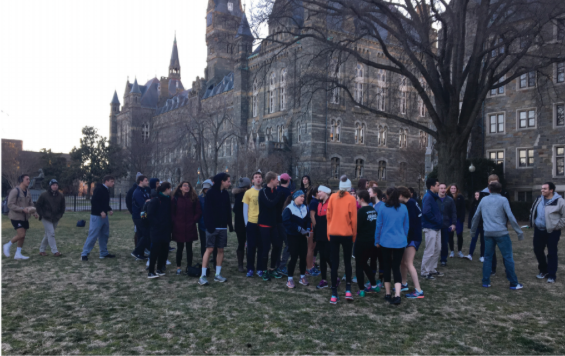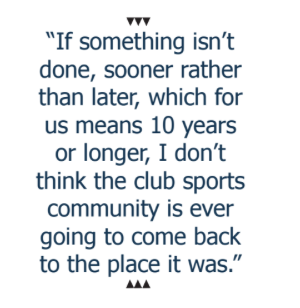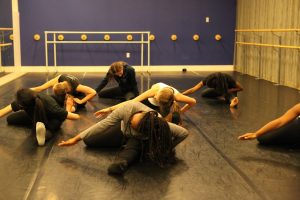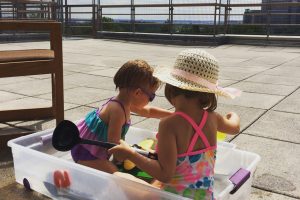When Kehoe Field closed, it was a long time coming. The playing space was notorious for its rough conditions, and Georgetown deemed it unsafe for practice conditions.
Although many felt the decision was necessary, the timing was unexpected.
“We just feel, as a community, as a board, individually, that the university has repeatedly made decisions that are going to be incredibly detrimental to our community and there’s no contingency plan,” said Daniel Fain (COL ‘18), chair of the Advisory Board for Club Sports (ABCS), co-chair of the GUSA Athletics Policy team, and president of Men’s Ultimate Frisbee.
Among the most affected teams has been men’s and women’s ultimate frisbee, two of the largest club teams on campus. After the closure was announced, it soon became apparent that the university did not have a contingency plan.
“There was no real alternative space that the university planned on having club sports and intramural (IM) athletes use,” said Jacob Marsh (COL ‘18), a captain of the Men’s Ultimate Frisbee team.. “Basically the consequence of Kehoe’s closure was that a lot of the athletes who do club sports, who do IM’s, who do these field sports, were left with no place to practice, no place to compete.”
There are more than 30 club sports teams at Georgetown, many of which, like Men’s and Women’s Ultimate Frisbee, compete at a Division I level.
“Club sports has been disproportionately affected by this sudden lack of field space because of our position as not a varsity sport but also not an intramural sport,” Anna Pettee (NHS ‘17), a captain of the Women’s Ultimate Frisbee team said. “The administration is assuming that club sports can continue to operate under these stressed conditions, but the experience that my team has had this past fall calls this assumption into question.”

Club sports demonstrates on Copley Lawn/Photo by Dan Fain
According to Pettee, over the next four weeks, her team will practice once per week off campus, and it has to be from 5 p.m. to dark, which makes it difficult to have full practices. “We know that there are multiple members of our team that won’t be able to make that,” she said. “It just puts an extra amount of stress on ourselves and our teammates who are already stretching themselves thin managing this responsibility with their other Georgetown responsibilities.”
The ABCS was planning on presenting to the Board of Regents about the conditions on the field before Kehoe’s closure last year, according to Fain. “When we did that, we were planning on pitching them that this is vital to our community and you really need to fix it,” Fain said. “Two days before that presentation, they informed us that Kehoe would be closed.”
The ABCS had been looking into alternative field space before Kehoe’s closure. Fain said that the board looked for off-campus fields as soon as Kehoe closed, and the project continued over the summer. “We went through every single field within D.C. Parks and Recreation and created a spreadsheet to figure out how far it was timewise and distance-wise to walk or drive and whether or not the field had lights,” he said.
Lighting on the fields is especially important because club sports teams have to accommodate their players’ schedules. They do not receive academic priority to miss class, so their practices must occur when after classes end for the day. On Kehoe, practices could occur late at night because of its lights. Two of the field options remaining for intramural and club sports, Burleith Field north of campus and Georgetown Visitation’s field, don’t have lights, restricting options for practice times to daylight hours, according to Perry Cao (SFS ‘17), a captain of the Men’s Ultimate Frisbee team. On short days in the fall semester when Cooper Field is used by both intramural and club sports, clubs are left with very limited practice options.
However, 5 p.m. off-campus practices are also difficult for students to attend because of class conflicts, Cao explained.
The lack of practice space has also harmed the team’s future. Cao said that the inconsistent scheduling and locations were difficult to communicate to the rest of the team, and dissuaded new players from staying. “We suffered a huge hit to recruitment,” he said.
“We had one of the smallest freshman classes coming out to the team that we’ve ever seen,” he said. “For a lot of people who wanted to join the team, they just couldn’t, because practice was happening when they had class or the timing was so inconsistent that they would make other plans because they just didn’t know when practice was going to be.”
Even without considering lighting and scheduling issues, finding any locations for practice has been difficult. Fain said that the ABCS sent out 35 requests through the department of Parks and Recreation to try to find other fields in the D.C. area, and were denied on all but two. “The two that we got are spaces that are comparable to Healy lawn,” he said. Both of the fields are 20 to 30 minutes by foot from campus.
Another issue is transporting equipment for practices to off-campus sites. While traveling to other fields may be feasible for certain club sports teams, other teams, like soccer and baseball, have equipment such as goals and batting cages that need to be transported as well if the field does not already have them.
Jihye Kim, program coordinator in the CSE who works with the ABCS to find practice space off campus, wrote in an email to the Voice that the university has a working relationship with the Parks and Recreation department to use a field in Burleith and Visitation.
 Aidan Delaney, the outreach chair for the ABCS, said that there is a possibility that portable lights might be purchased as a quick fix for field options like Burleith and Visitation. He estimated the cost at $20,000, money that he said would come from the administration.
Aidan Delaney, the outreach chair for the ABCS, said that there is a possibility that portable lights might be purchased as a quick fix for field options like Burleith and Visitation. He estimated the cost at $20,000, money that he said would come from the administration.
“The [ABCS] is not too excited about that because we feel like if we were to go through with that plan, then they might be able to put off fixing Kehoe for another five to 10 years,” he said. “To some extent it would be helpful because the lights would be moveable … they only go so high. I think they’re 14 feet high, so sports like softball and baseball wouldn’t be able to use them.”
There is a lot of uncertainty about the future of practice space on campus. Delaney said that any field option has cons. “Whether it’s travel, whether it’s lights, just having teams willing to go and actually practice there, and you have to account for the safety of these fields,” he said. “A lot of them have potholes and are really poorly kept.” He continued that some of the potential fields are just as dangerous as Kehoe, if not worse.
While both short-term and long-term answers are up for consideration, the solutions presented by the university would require an extended period of time. Connor Maytnier (COL ‘18), the student representative to the Board of Directors, explained that the university’s long-term plan is the development of an athletic district on campus.
“This plan would build an entirely new recreation center, a new Shaw field, and a new Kehoe field,” he wrote in an email to the Voice. “This redevelopment plan, however, is being considered on a 10-year timeline, and realistically would require even more than 10 years from approval until completion. Thus, we are looking at at least a decade with the current facilities in place.”
What makes renovating Kehoe logistically challenging is its location on top of Yates Field House. The 2017 Campus Plan states that renovation options for both Yates and Kehoe are limited and costly, and proposes demolishing Yates entirely and replacing it with a new facility. The cost and timing of repair to either Yates or Kehoe has not yet been determined, univeristy spokesperson Rachel Pugh wrote in an email to the Voice.
Kehoe’s issues stem from its original design in the 1970s and not a lack of maintenance. “The design did not properly address controlling rainwater as the field is flat and consequently water sits on the field,” Pugh wrote in an email to Voice. “This condition over time degrades the roof and has resulted in the unsafe conditions.”
Maytnier wrote that given the inadequate temporary field arrangements and the negative effects already seen in year one, it is extremely important for the university to re-invest in Kehoe and pursue a short-term renovation. “Such a renovation would allow us to re-open the field and extend Kehoe’s lifespan by 10 years–the time needed before the university’s larger vision for the future of the ‘”athletic district’” can be fully realized,” he wrote
“The university is currently considering a range of options to address the long term needs of Yates and Kehoe,” Pugh wrote. “The options include repair of Kehoe Field and continued investments in Yates to the development of a new recreation center and fields.”
Club sports has made attempts to draw attention to their situation. A demonstration was held on Copley Lawn on Thursday, Feb. 16th, which Fain said had 70 participants at its peak. Maytnier presented a letter to the Board of Directors that several captains of club sports teams signed to urge the university to pursue a short-term renovation of Kehoe. “The Board members echoed the concerns of the team captains, however the finances necessary to pursue the renovation still remain in question,” he wrote. “We are hopeful that the university will make these finances a top priority in the near future, but that remains uncertain as of now.”
Club sports has been one of the largest growing communities at Georgetown. Fain said that six years ago, there were 11 club sports teams, which have grown into more than 30 today. “If something isn’t done, sooner rather than later, which for us means 10 years or longer, I don’t think the club sports community is ever going to come back to the place it was,” Fain said. “I don’t see sustained levels of participation or any possible chance of growth under the current system.”





